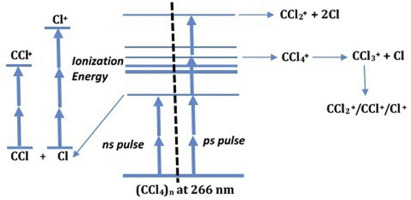当前位置:
X-MOL 学术
›
Int. J. Mass Spectrom.
›
论文详情
Our official English website, www.x-mol.net, welcomes your feedback! (Note: you will need to create a separate account there.)
Interaction of (CCl4)n clusters with nanosecond and picosecond laser pulses at discrete wavelengths spanning from IR to UV region: A comparative study using TOFMS
International Journal of Mass Spectrometry ( IF 1.8 ) Pub Date : 2020-04-01 , DOI: 10.1016/j.ijms.2020.116291 Pramod Sharma , Soumitra Das , Rajesh K. Vatsa
International Journal of Mass Spectrometry ( IF 1.8 ) Pub Date : 2020-04-01 , DOI: 10.1016/j.ijms.2020.116291 Pramod Sharma , Soumitra Das , Rajesh K. Vatsa

|
Abstract Using time-of-flight mass spectrometer (TOFMS), photochemistry of carbon tetrachloride clusters ((CCl4)n) has been investigated upon interaction with nanosecond and picosecond Nd:YAG laser pulses (266, 355, 532 and 1064 nm) spanning over intensity range of ∼1.2 × 109 to 7.9 × 1012 W/cm2. At all the laser wavelengths upon interaction of (CCl4)n clusters with laser pulse, multiphoton excitation leads to excessive fragmentation of cluster constituents, which are subsequently ionized by multiphoton absorption process. Depending on laser wavelength and pulse duration, at 266 and 355 nm these clusters exhibit dominant ion signal corresponding to singly charged fragment ions i.e. Cl+, CCl+, CCl2+ and CCl3+ in the mass spectra. In addition, for studies carried out at 266 nm using picosecond laser pulses minor ion signal corresponding to C2Cl+ and C2Cl2+ were also observed. Generation of these ions has been ascribed to intra-cluster radical chemistry resulting in generation of neutral precursors, which subsequently are multiphoton ionized. At 532 and 1064 nm, dominant ion signal corresponding to multiply charged atomic ions of carbon (up to C4+/C5+) and chlorine (up to C11+) have been observed. Though multiphoton absorption is the primary process driving the photochemistry of (CCl4)n clusters, observation of multiply charged atomic ions at 532 and 1064 nm has been ascribed to dominant role played by quasi-free electrons which are confined within the ionized cluster, in efficient coupling of laser energy at longer laser wavelengths via inverse Bremsstrahlung process.
中文翻译:

(CCl4)n 簇与从 IR 到 UV 区域离散波长的纳秒和皮秒激光脉冲的相互作用:使用 TOFMS 的比较研究
摘要 使用飞行时间质谱仪 (TOFMS),研究了四氯化碳簇 ((CCl4)n) 与纳秒和皮秒 Nd:YAG 激光脉冲(266、355、532 和 1064 nm)相互作用时的光化学。强度范围约为 1.2 × 109 至 7.9 × 1012 W/cm2。在 (CCl4)n 团簇与激光脉冲相互作用后的所有激光波长下,多光子激发导致团簇成分过度碎裂,随后通过多光子吸收过程电离。根据激光波长和脉冲持续时间,在 266 和 355 nm 处,这些簇显示出与质谱中单电荷碎片离子(即 Cl+、CCl+、CCl2+ 和 CCl3+)相对应的主要离子信号。此外,对于使用皮秒激光脉冲在 266 nm 进行的研究,还观察到了对应于 C2Cl+ 和 C2Cl2+ 的次要离子信号。这些离子的产生归因于簇内自由基化学导致中性前体的产生,这些前体随后被多光子电离。在 532 和 1064 nm 处,观察到与碳(最多 C4+/C5+)和氯(最多 C11+)的多电荷原子离子对应的主要离子信号。尽管多光子吸收是驱动 (CCl4)n 团簇光化学的主要过程,但在 532 和 1064 nm 处观察到的多电荷原子离子被认为是由限制在电离团簇内的准自由电子所起的主导作用,有效通过逆轫致辐射过程在较长激光波长下耦合激光能量。
更新日期:2020-04-01
中文翻译:

(CCl4)n 簇与从 IR 到 UV 区域离散波长的纳秒和皮秒激光脉冲的相互作用:使用 TOFMS 的比较研究
摘要 使用飞行时间质谱仪 (TOFMS),研究了四氯化碳簇 ((CCl4)n) 与纳秒和皮秒 Nd:YAG 激光脉冲(266、355、532 和 1064 nm)相互作用时的光化学。强度范围约为 1.2 × 109 至 7.9 × 1012 W/cm2。在 (CCl4)n 团簇与激光脉冲相互作用后的所有激光波长下,多光子激发导致团簇成分过度碎裂,随后通过多光子吸收过程电离。根据激光波长和脉冲持续时间,在 266 和 355 nm 处,这些簇显示出与质谱中单电荷碎片离子(即 Cl+、CCl+、CCl2+ 和 CCl3+)相对应的主要离子信号。此外,对于使用皮秒激光脉冲在 266 nm 进行的研究,还观察到了对应于 C2Cl+ 和 C2Cl2+ 的次要离子信号。这些离子的产生归因于簇内自由基化学导致中性前体的产生,这些前体随后被多光子电离。在 532 和 1064 nm 处,观察到与碳(最多 C4+/C5+)和氯(最多 C11+)的多电荷原子离子对应的主要离子信号。尽管多光子吸收是驱动 (CCl4)n 团簇光化学的主要过程,但在 532 和 1064 nm 处观察到的多电荷原子离子被认为是由限制在电离团簇内的准自由电子所起的主导作用,有效通过逆轫致辐射过程在较长激光波长下耦合激光能量。


























 京公网安备 11010802027423号
京公网安备 11010802027423号